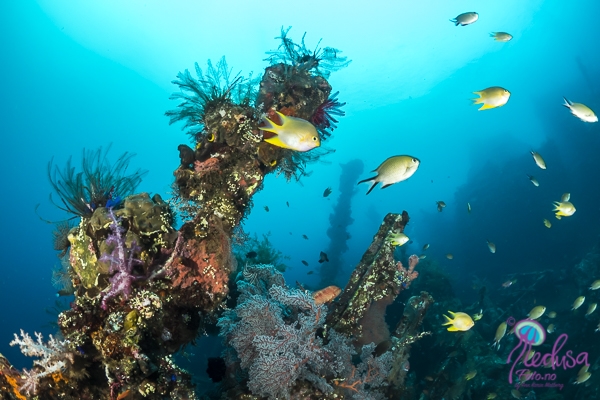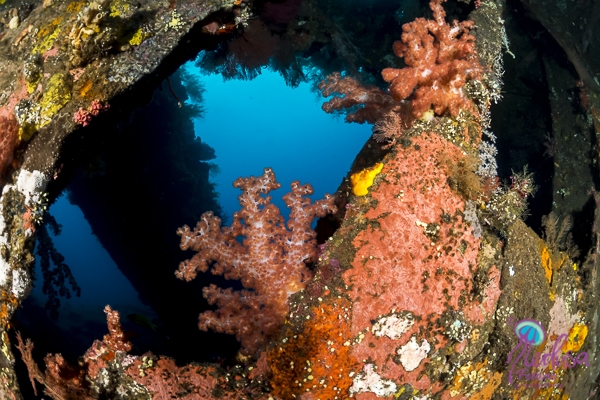Just the sound of the name Bali brings stars into people’s eyes. Images of white, sandy beaches, palm trees and warm crystal clear water pass through the mind – and for all the best reasons. Stretching over almost 2 million square kilometers between the Indian and the Pacific Ocean, the world’s largest island country, Indonesia, hosts many of the greatest dive spots in the world. In the south middle part lays the island of Bali, a popular destination for tourists and famous for its highly developed arts and housing most of the Hindu minority in Indonesia. Since Bali is located in the so-called Golden Triangle, with the highest biodiversity of marine species in the world, diving is one of the highlights when visiting this beautiful island. As Bali is a volcanic island, most of the beaches are black, either sandy or stony beaches. The exception is in the southern part of the island, where white sandy beaches have become a surfers paradise.
At the north east side of Bali, the water is usually warmer than in the south, ranging between 26 and 29 degrees. One of the most well-known dive areas is Tulamben. Here you can experience nice, healthy coral reefs, easily accessible wrecks, steep wall diving or let yourself be fascinated with the amazing world of nudibranchs.

Ann Karin Matberg • OM-D E-M1 • M.ZUIKO DIGITAL ED 8mm 1:1.8 Fisheye PRO
• PT-EP11 • PPO-EP02 • 2 x UFL-3
Originally, Tulamben was a small fishing village. And even though tourism has increased immensely over the last ten years, you can still see the traditional jukung-boats head out to the sea every morning and afternoon when locals go out to catch their food. The sight of these small outrigger canoes with their colorful sails is a joy to watch as they cross the ocean. Since diving became more popular, the jukungs are also used as diving boats and I promise you that it is the narrowest dive boat you´ll ever ride!
USAT Liberty is the most famous dive site in the Tulamben area. It is probably the most easily accessible large shipwreck in the world, located only 20 meters from the beach. No need for dive boats, long surface swims or special education.
The shallowest part of the wreck is at 6 meters, so you can actually snorkel on it. The deepest part lays around 30 m. You just go down to the beach, gear up, walk into the water – and after a very short swim you are there. The beach is made out of round stones and sometimes the waves can be big, so getting in and out can be tricky at times. But mostly, the sea is flat, and wreck diving can’t be easier than this!

Ann Karin Matberg • OM-D E-M1 • M.ZUIKO DIGITAL ED 8mm 1:1.8 Fisheye PRO
• PT-EP11 • PPO-EP02 • 2 x UFL-3
A couple of years ago, the wreck was still quite intact, and no matter from what side you approached, it made a huge impression when the shade of the 125 m long, 13 000 ton huge boat came into sight.
After being hit by a Japanese torpedo in 1942, Liberty was stranded on the beach in Tulamben. When the majestic volcano Agung erupted in 1963, everything of value had already stripped from the wreck, and the lava flow gently pushed the wreck out from the beach to where it has been resting ever since.
After 50 years in the sea, it was just a matter of time before the wreck would collapse. In 2012, the ship was in a good condition, but the last years have had a great impact on the construction and many of the former well known contours are now gone. In the front part, huge barrel sponges grew and a few years later it was quite scary to see these enormous, almost man sized sponges moving up and down due to movements the waves made on the steel construction. It was obvious that this would soon give in to gravity, and parts of the wreck were marked as unsafe for divers to swim trough.
Today you can still swim through what’s left of one of the large cargo rooms. You should pay special attention to the sides – hard and soft corals grow there and make out great photographic objects!

Ann Karin Matberg • OM-D E-M1 • M.ZUIKO DIGITAL ED 8mm 1:1.8 Fisheye PRO
• PT-EP11 • PPO-EP02 • 2 x UFL-3
Even though this is a very much used dive site, also by inexperienced divers, the aquatic life on the wreck is in a very good shape. The surface of the wreck houses huge coral fans, soft corals, lots of hydroids and sponges, literally every centimeter of the wreck is transformed into an artificial reef. As a photographer, this is an interesting dive site both as a wide angle photographer, and for macro shots. A huge number of animals live on and around Liberty. Amongst them is a 2 meter long barracuda, which can sometimes give you a chill if you are too focused on the small stuff and suddenly find yourself face to face with enormous, needle sharp teeth.
Divers from all around Bali are transported to Tulamben every day to dive at this famous site. If you stay in the area, better dive early in the morning or late afternoon. Most likely you’ll have the wreck almost to your own, and you have the chance to come close to the biggest parrotfish of them all.
The resident school of humphead parrotfish moves away from the wreck during daytime, but sleeps around Liberty and comes back every evening.
And as the humphead parrotfish is going to sleep, so are we.
In a couple of days, we’ll head for some other great dive spots here in Bali. Stay tuned.
Comments
Show more comments (1)